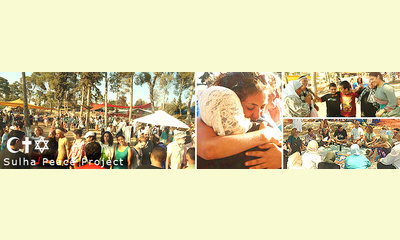|
|
Sulha Peace Project. An alternative conflict resolution method.
un articulo por Pablo Pejlatowicz
Based on an ancient community-based conflict
resolution tool, a group of Palestinians and
Israelis brought together a monthly joint
experience, designed so the participants can freely
share their feelings and opinions on essential
humanity issues. 
click on photo to enlarge
Ever since 2001, Sulha Peace Project has provided a
monthly space for more than 100 teenagers, women and
men from Israel and Palestine to gather around a
tribal fire, have a meal together, dance, sing, and
share their visions of possible futures.
Humane bonding in small groups, in a region where
cultural and religious difference have originated
bloodshed and pain, shows that a culture of peace
can spring and be fostered in every community, with
the slightest effort.
As the Sulha Peace Project coordinators state in
their webpage: “in contrast to the current
atmosphere of distrust, cynicism and despair, we
stand for the possibility of cooperation, shared
responsibility, and hope.”
They also manifested that “while our societies
demonize those on the other side, we humanize
them. Through our common efforts, we create
interaction between our peoples while others
alienate. While we avoid polarizing political
declarations, we know that any political future
must address the human needs of both sides, and we
stand on the front lines of the struggle to return
decency and compassion to our shared land”.
If you want to have a first-hand experience of the
Tribal Fires held in Israel or the West Bank, you
can attend the ‘Sulha’ or the ‘Sulhita’ for youths,
and contact Nibal at 054-3257561 or write to
contact.sulha@gmail.com
More information: www.sulha.com
Click here for a Spanish version of this article.
|








|
DISCUSSION
Pregunta(s) relacionada(s) al artículo :
Is there a renewed movement of solidarity by the new generation?,
* * * * *
Comentario más reciente:
from Javier Collado Ruano, Director of Edition at Global Education Magazine, on the occasion of the International Day of Solidarity.
Solidarity is a trans-dimensional phenomenon that goes beyond the ontological essence of human nature. In fact, when we analyze the connections between the microcosm and the macrocosm, we perceive that human beings are not involved in chaos and arbitrariness, but belongs to the large network of interdependencies, complementarities and reciprocities that constitute life. The emergence of life on Earth, around 3,8 billion years ago, was a complex process of exceptional natural phenomena, inherent in all living systems. A process which is expressed through unlimited creativity: mutation, gene exchange, and symbiosis. From a cosmo-biological perspective, we can understand a new conceptual dimension of life, where all living beings share same basis of genetic code: the twenty amino-acids and four phosphatic bases. In fact, the diversity of living beings is caused by the combination of this cosmo-bio-genetic basis.
This trans-dimensional perspective has a deep ecological and spiritual sense for our worldview because the human evolutionary adventure is the latest stage of life on Earth. The modern human being is a vertebrate animal, mammal, belonging to the primates, which emerged 200,000 years ago. In recent centuries he has imposed its anthropocentric, industrial and capitalist vision to the detriment of Pachamama (and Indigenous goddess known as earth mother). We consume around 120% of the natural resources that Earth Mother regenerats annually. Our consumer behavior is immersed in a fatalistic dynamic with a destiny to climate change (deforestation, loss of biodiversity, ozone, etc.), and our own self-destruction as a species.
There is an urgent need to get beyond the cognitive fallacy that the mental structures of social Darwinism and capitalist postulates of the 19th century have historically constituted, because they only understand natural and social systems as warmongers and competitive processes whereby species diverge from each other. . ... continuación.

|
|









